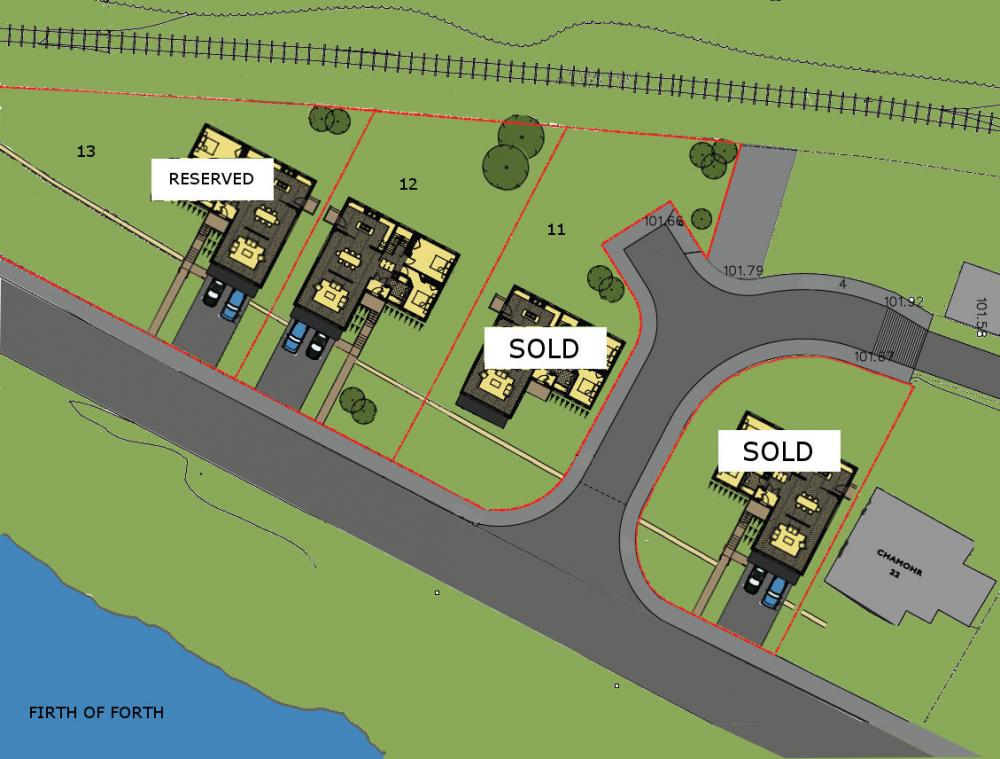Act III - Buying the Plot, Wayleaves and Servitudes
It’s May 2015 and around 4 months since we first saw the plot and 3 months since we decided not to buy it. There were various reasons for this:
- The was a train line running along the rear of the plot, serving the local power station
- There was a BP pipeline running through the border of our plot, imposing a 3.5 meter no build zone on our plot
- We’d never done anything like this before. We were not self-builders. Buying a plot was for people on Grand Designs or Building the Dream, not people like us who bought a house, moved our furniture into it and painted a few walls. The extent of our renovation experience was replacing a lean-to sun-room with a conservatory – that room did extend out beyond the original floor space, so required planning permission, but we had very little involvement in the whole process. It did not involve a 3 foot high pressure oil and gas pipeline. And I was not a trainspotter.
This sit map shows Plots 11 and 12.
Ours is Plot 12.
Whilst the existence of the pipeline and no-build zone was an obvious inconvenience, we’d spoken to the builder aligned to the plot, and because we had planning permission and because we were assured that good progress was being made on getting the foundation design approved by the pipeline owner, we were comforted in that respect. We trusted what we were told, But with the benefit of hindsight, that trust was misplaced.
However, from my hazy recollection of those discussions 2 years ago, it was actually the existence of the train line that was the ultimate decider in us not purchasing the plot at that time. As far as we could ascertain, only 4 trains ran per week, but they were long, trundly, noisy trains, with carriages filled with coal, and this did not really appeal to us.
So, we walked away.
But, 3 months later, we were back looking at the plot. We’d spent those intervening 3 months looking at other houses for sale (we’d still not yet put our own home on the market) but couldn’t find somewhere we both loved. Perhaps critically, we revisited the plot one day and started speaking to the lovely couple who were building the house on the plot to the west of ours. They had previous experience of self-building, at varying levels of involvement, from instructing a main contractor through the project managing and arranging all the sub-contractors themselves.
We met with them a couple of times thereafter, and it’s fair to say that they allayed many of the concerns we had, particularly the minimal impact the railway line was having on their lives, although at that time, their build was still in progress and they were living in a caravan on-site.
I can’t remember exactly when we made a decision to buy the plot, but things moved fast once we did. We agreed to meet the builder on-site, and within a week we’d put in a note of interest on the plot and put down a small deposit to have it removed from the market. We also put our own home on the market at the same time (to release capital), and changed our own house search to find a temporary place to live whilst the build was to take place.
It took nearly 3 more months to conclude the purchase of the plot. It was during this time that we first heard the phrases Wayleave Agreement and Deed of Servitude from our solicitor. Wayleaves have been discussed on this board before, so I won’t go into details, but in our case, it effectively gives the pipeline owner the right to access the ground above and around the pipeline. The Deed of Servitude is the legal document in which these rights are documented. Interestingly (and this will be the subject to future posts) it details the rights and responsibilities of both the pipe owner and plot owner with regards to the pipeline. We finally legally owned the plot in the middle August 2015.
More time than really should have been necessary was spent on getting a decision as to whether we could actually place a fence on the boundary of our plot (which was shown to be directly above the pipeline), but we (and the owner of the plot to the east of us) had discussions with the pipeline owners Wayleave team and finally got confirmation that there would be no issue here.
During these discussions we also got more information about the positioning of the pipeline in relation to the plot. This side elevation shows the run of the pipeline underground (though we've since organised a significant soil shift since this was created):
This drawing also showed the results of the discussions that had already taken place regarding the foundations for the approved house. The depth of the foundation, we were told, was to ensure that no load was put onto the pipeline. We had also met with the architect who designed the house, and he explained that so long as there was a 45 degree angle between the bottom of the foundations and the bottom of the pipeline, then the pipe owners were happy.
We never knew at the time, but the foundation design is something that caused (and is still causing) much angst in our build process.



21 Comments
Recommended Comments
Create an account or sign in to comment
You need to be a member in order to leave a comment
Create an account
Sign up for a new account in our community. It's easy!
Register a new accountSign in
Already have an account? Sign in here.
Sign In Now